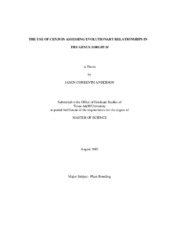| dc.description.abstract | A DNA sequence-based phylogenetic tree (Dillon et al., 2004) places the species
of the genus Sorghum into two sister lineages, one with x = 5 and the other with x = 10
as a basic chromosome number. It has not been resolved whether or not these lineages
are monophyletic or polyphyletic. A repetitive sequence, CEN38, found only in
Sorghum and sugarcane, was used to assess evolutionary relationships among Sorghum
species. The objectives of this research were to determine the taxonomic distribution of
CEN38, its chromosomal position(s), and its organization in DNA. CEN38 was detected
by filter hybridization to be present in the DNA of 16 of 21 Sorghum species analyzed,
ranging from 15 to ~21,000 copies. It was detected by fluorescence in situ hybridization
(FISH) only in chromosomes of species of the section Eu-sorghum, where it had a
pericentromeric distribution. The low copy number and/or chromosomal distribution of
CEN38 in other Sorghum species apparently does not allow for its detection by FISH.
Analysis of restriction enzyme digested DNA with homology to CEN38 and of
fragments amplified by PCR using primers selected to amplify S. bicolor CEN38
sequences showed that S. laxiflorum and S. macrospermum have tandemly arranged
CEN38 sequences as is found in S. bicolor. This supports the close evolutionary affinity of the species in the x = 10 lineage. In the x = 5 lineage, DNA of 11 of 16 species
analyzed hybridized with CEN38 by filter hybridization. In S. versicolor, large DNA
fragments (4.36 kb to 23 kb) generated by digestion with restriction enzymes hybridized
to CEN38. Since a ladder of smaller fragments was not detected, CEN38 may have been
inserted into a transposable element in this species and dispersed throughout the genome.
Among species of the x = 5 lineage, PCR using primers for S. bicolor CEN38 amplified
only DNA fragments from S. timorense and these formed a ladder based on a ~125 bp
repeat. Since hybridization of the CEN38 sequence to DNA of S. timorense was not
detected by filter hybridizations, these sequences apparently are not similar to CEN38.
Cloning and sequencing of DNA from species of the x = 5 lineage that hybridizes to
CEN38 are needed to determine whether or not they are in the CEN38 family. A
monophyletic or polyphyletic origin of the x = 5 and x = 10 lineages was not resolved. | en |


